Protected Areas Under Threat: Unravelling the Protected Areas Downgrading, Downsizing, and Degazettement (PADDD) Events in Myanmar in a Global Context: 1989–2020
Abstract
1. Introduction
2. Materials and Methods
2.1. Data Sources
2.2. Data Collection
2.3. Land Cover and Threatened Species Data
2.4. Analysis of Land Cover and Fragmentation
3. Results
3.1. Myanmar PADDD Events in the Global Context Between 1989 and 2020
3.2. Spatiotemporal Patterns and Causes of Enacted PADDD Events in Myanmar
3.3. Comparison of Land Cover and Landscape Pattern Between 2000 and 2020 for Three PAs
3.4. Impacts of PADDD Events on Threatened Species
4. Discussion
5. Conclusions
Author Contributions
Funding
Data Availability Statement
Acknowledgments
Conflicts of Interest
Abbreviations
| GBF | Global Biodiversity Framework |
| IUCN | International Union for Conservation of Nature |
| PADDD | PA Downgrading, Downsizing, and Degazettement |
| PAs | Protected Areas |
Appendix A
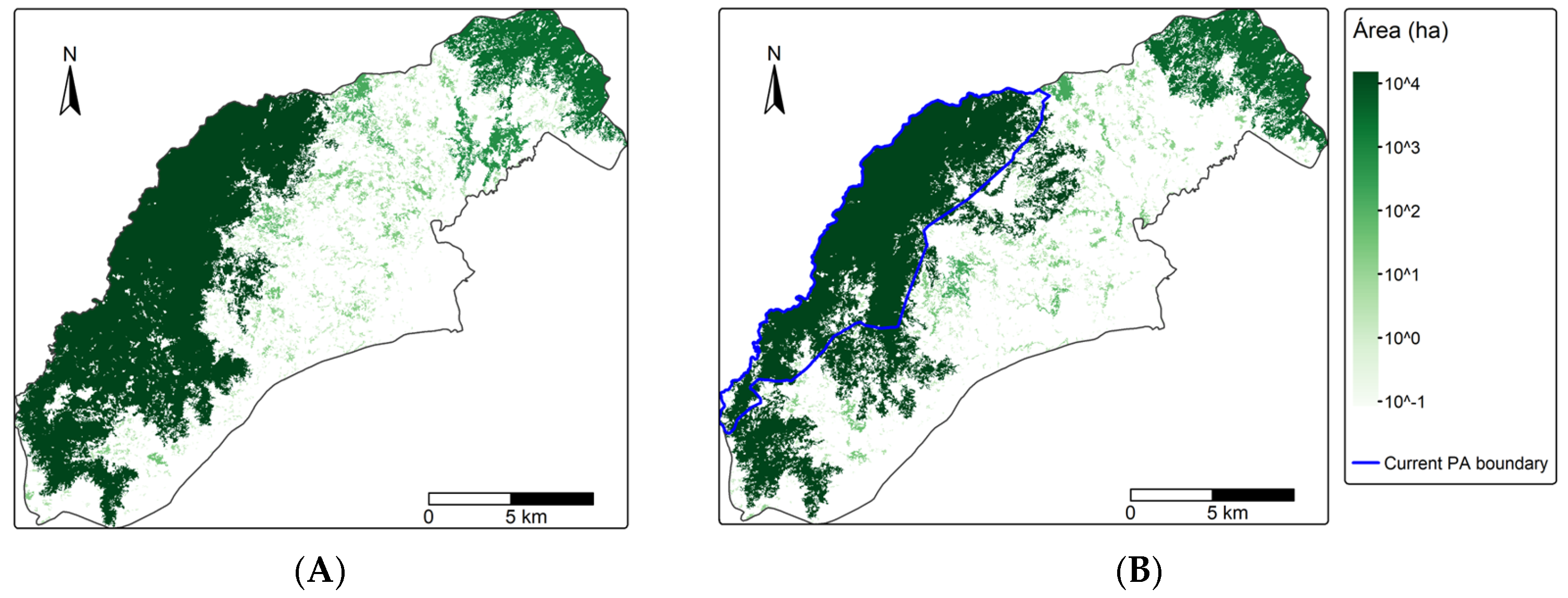

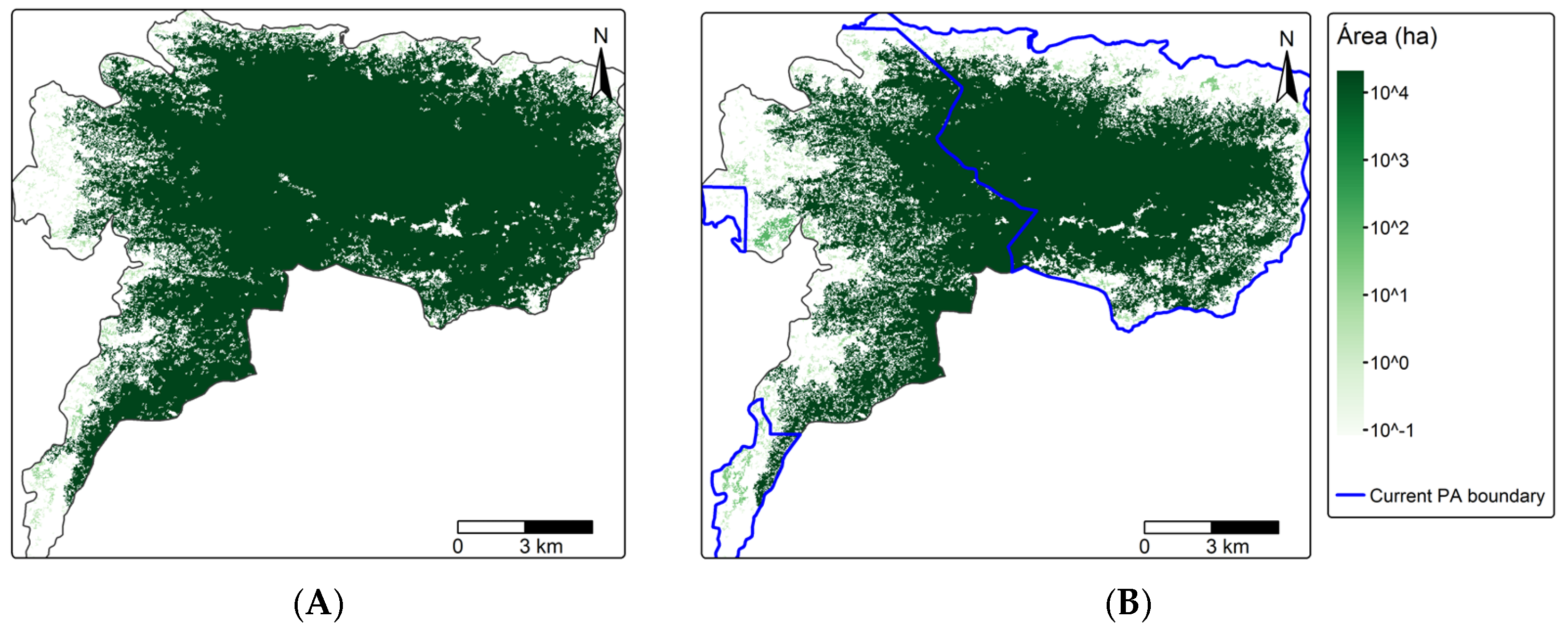

| Sr. | Name of PA | PA category | State/ Region | Established Year | Current Area (ha) | Downsizing | |
|---|---|---|---|---|---|---|---|
| Number | % | ||||||
| 1 | Alaungdawkathapa | National Park | Sagaing | 1989 | 140,283 | 1 | 12.19 |
| 2 | Chatthin | Wildlife Sanctuary | Sagaing | 1941 | 26,007 | 1 | 3.45 |
| 3 | Hlawga Park | Nature Park | Yangon | 1989 | 560 | 5 | 10.13 |
| 4 | Hukaung Valley Extension | Wildlife Sanctuary | Sagaing | 2010 | 1,089,932 | 1 | 0.94 |
| 5 | Indawgyi | Wildlife Sanctuary | Kachin | 2004 | 74,791 | 6 | 8.23 |
| 6 | Inlay Lake | Wildlife Sanctuary | Shan | 1985 | 53,374 | 12 | 16.91 |
| 7 | Kaylathataung | Wildlife Sanctuary | Mon | 1942 | 2245 | 4 | 8.26 |
| 8 | Kyaiktiyo | Wildlife Sanctuary | Mon | 2001 | 15,602 | 4 | 0.14 |
| 9 | Lampi | Marine National Park | Taninthayi | 1996 | 20,449 | 2 | 0.18 |
| 10 | Loimwe | Nature Reserve | Shan | 1996 | 4135 | 2 | 3.47 |
| 11 | Minsontaung | Wildlife Sanctuary | Mandalay | 2001 | 2256 | 1 | 0.15 |
| 12 | Natmataung | National Park | Chin | 2010 | 71,308 | 1 | 0.06 |
| 13 | Parsar | National Park | Shan | 1996 | 7653 | 1 | 0.64 |
| 14 | Pidaung | Wildlife Sanctuary | Kachin | 1927 | 12,208 | 6 | 82.66 |
| 15 | Pyin-Oo-Lwin Bird Sanctuary | Wildlife Sanctuary | Mandalay | 1927 | 11,102 | 11 | 12.52 |
| 16 | Shwesettaw | Wildlife Sanctuary | Magway | 1940 | 46,410 | 3 | 16.03 |
| 17 | Shwe-U-Daung | Wildlife Sanctuary | Mandalay/Shan | 1927 | 17,598 | 2 | 46.01 |
| 18 | Taninthayi | Nature Reserve | Taninthayi | 2005 | 169,996 | 1 | 0.004 |
| 19 | Taunggyi Bird Sanctuary | Wildlife Sanctuary | Shan | 1920 | 728 | 7 | 54.69 |
| 20 | Wetthigan | Wildlife Sanctuary | Magway | 1939 | 372 | 2 | 15.51 |
References
- Dudley, N. Guidelines for Applying Protected Area Management Categories; IUCN: Gland, Switzerland, 2008; p. x + 86. Available online: https://portals.iucn.org/library/sites/library/files/documents/pag-021.pdf (accessed on 29 August 2025).
- Watson, J.E.M.; Dudley, N.; Segan, D.B.; Hockings, M. The performance and potential of protected areas. Nature 2014, 515, 67–73. [Google Scholar] [CrossRef]
- UNEP-WCMC. Map of Protected Areas and OECMs, February 2025. 2025. Available online: www.protectedplanet.net (accessed on 5 February 2025).
- CBD COP. Kunming-Montreal Global Biodiversity Framework (GBF). In Proceedings of the Fifteenth Meeting of the Conference of the Parties to the Convention on Biological Diversity (Part Two) Decision 15/4, Montreal, QC, Canada, 7–19 December 2022. [Google Scholar]
- Mascia, M.B.; Pailler, S. Protected area downgrading, downsizing, and degazettement (PADDD) and its conservation implications. Conserv. Lett. 2011, 4, 9–20. [Google Scholar] [CrossRef]
- Mascia, M.B.; Pailler, S.; Krithivasan, R.; Roshchanka, V.; Burns, D.; Mlotha, M.J.; Murray, D.R.; Peng, N. Protected area downgrading, downsizing, and degazettement (PADDD) in Africa, Asia, and Latin America and the Caribbean, 1900–2010. Biol. Conserv. 2014, 169, 355–361. [Google Scholar] [CrossRef]
- Conservation International; World Wildlife Fund. PADDDtracker.org Data Release, version 2.1; Conservation International: Arlington, VA, USA; World Wildlife Fund: Washington, DC, USA, 2021. Available online: https://zenodo.org/records/4974336 (accessed on 9 December 2024).
- Golden Kroner, R.E.; Qin, S.; Cook, C.N.; Krithivasan, R.; Pack, S.M.; Bonilla, O.D.; Cort-Kansinally, K.A.; Coutinho, B.; Feng, M.; Martínez Garcia, M.I. The uncertain future of protected lands and waters. Science 2019, 364, 881–886. [Google Scholar] [CrossRef]
- Conceição, E.O.; Garcia, J.M.; Alves, G.H.Z.; Delanira-Santos, D.; de Fátima Corbetta, D.; Betiol, T.C.C.; Pacifico, R.; Romagnolo, M.B.; Batista-Silva, V.F.; Bailly, D. The impact of downsizing protected areas: How a misguided policy may enhance landscape fragmentation and biodiversity loss. Land Use Policy 2022, 112, 105835. [Google Scholar] [CrossRef]
- Golden Kroner, R.E.; Krithivasan, R.; Mascia, M.B. Effects of protected area downsizing on habitat fragmentation in Yosemite National Park (USA), 1864–2014. Ecol. Soc. 2016, 21, 22. [Google Scholar] [CrossRef]
- Tesfaw, A.T.; Pfaff, A.; Golden Kroner, R.E.; Qin, S.; Medeiros, R.; Mascia, M.B. Land-use and land-cover change shape the sustainability and impacts of protected areas. Proc. Natl. Acad. Sci. USA 2018, 115, 2084–2089. [Google Scholar] [CrossRef]
- Forrest, J.L.; Mascia, M.B.; Pailler, S.; Abidin, S.Z.; Araujo, M.D.; Krithivasan, R.; Riveros, J.C. Tropical Deforestation and Carbon Emissions from Protected Area Downgrading, Downsizing, and Degazettement (PADDD). Conserv. Lett. 2015, 8, 153–161. [Google Scholar] [CrossRef]
- Nuttall, M.; Olsson, E.; Washington, H.; Ung, V.; Bunnefeld, N.; Merriman, J.; Griffin, O.; Hobson, K.; Diment, A.; Kroner, R.G. Protected area downgrading, downsizing, and degazettement in Cambodia: Enabling conditions and opportunities for intervention. Conserv. Sci. Pract. 2023, 5, e12912. [Google Scholar] [CrossRef]
- Ford, S.A.; Persson, J.; Jepsen, M.R.; Mertz, O. Sociopolitical drivers and environmental outcomes of protected area downgrading and degazettement in Cambodia. Reg. Environ. Change 2022, 22, 114. [Google Scholar] [CrossRef]
- Fuller, R.A.; McDonald-Madden, E.; Wilson, K.A.; Carwardine, J.; Grantham, H.S.; Watson, J.E.; Klein, C.J.; Green, D.C.; Possingham, H.P. Replacing underperforming protected areas achieves better conservation outcomes. Nature 2010, 466, 365–367. [Google Scholar] [CrossRef] [PubMed]
- Kareiva, P. Trade-in to trade-up. Nature 2010, 466, 322–323. [Google Scholar] [CrossRef] [PubMed]
- Dowie, M. Conservation Refugees: The Hundred Year Conflict Between Global Conservation and Native Peoples; The MIT Press: Cambridge, MA, USA, 2009. [Google Scholar]
- Bernard, E.; Penna, L.A.; Araújo, E. Downgrading, downsizing, degazettement, and reclassification of protected areas in Brazil. Conserv. Biol. 2014, 28, 939–950. [Google Scholar] [CrossRef] [PubMed]
- Paterson, A. The Judiciary’s Contribution to Preventing Protected Area Downgrading, Downsizing, and Degazettement: Mining and Environmental Justice Community of South Africa v MEC for Agriculture, Rural Development Land and Environmental Affairs (1322/2021)[2024] ZAMPMBHC 48 (18 July 2024). Potchefstroom Electron. Law J. PELJ 2025, 28, 1–28. [Google Scholar] [CrossRef]
- Lopez Sandoval, M.F.; Gerique, A.; Pohle, P. What Is Behind Land Claims? Downsizing of a Conservation Area in Southeastern Ecuador. Sustainability 2017, 9, 1519. [Google Scholar] [CrossRef]
- Keles, D.; Delacote, P.; Pfaff, A.; Qin, S.; Mascia, M.B. What drives the erasure of protected areas? Evidence from across the Brazilian Amazon. Ecol. Econ. 2020, 176, 106733. [Google Scholar] [CrossRef]
- Herziger, A.; Claborn, K.A.; Brooks, J.S. Is there hope for the double dividend? How social context can shape synergies and tradeoffs between sustainable consumption and well-being. Ecol. Econ. 2020, 176, 106736. [Google Scholar] [CrossRef]
- Peterson, M.N.; Birckhead, J.L.; Leong, K.; Peterson, M.J.; Peterson, T.R. Rearticulating the myth of human–wildlife conflict. Conserv. Lett. 2010, 3, 74–82. [Google Scholar] [CrossRef]
- Tordoff, A.W.; Duckworth, J.W.; Macfarlane, C.; Ravn, M.; Tallant, J. Indo-Burma Biodiversity Hotspot 2020 Update; Critical Ecosystem Partnership Fund: Arlington, VA, USA, 2020. [Google Scholar]
- IUCN. Indomalaya, Oceania, Australia and Antarctic. In Protected Areas of the World: A Review of National Systems; IUCN: Gland, Switzerland; Cambridge, UK, 1992; Volume 1. [Google Scholar]
- Forest Department. National Biodiversity Strategy and Action Plan (2015–2020); Forest Department, Ministry of Natural Resources and Environmental Conservation: Nay Pyi Taw, Myanmar, 2015; Consulted by IUCN; p. 137. [Google Scholar]
- Aung, U.M. Policy and practice in Myanmar’s protected area system. J. Environ. Manag. 2007, 84, 188–203. [Google Scholar] [CrossRef]
- Rao, M.; Rabinowitz, A.; Khaing, S.T. Status Review of the Protected-Area System in Myanmar, with Recommendations for Conservation Planning. Conserv. Biol. 2002, 16, 360–368. [Google Scholar] [CrossRef]
- Istituto Oikos; BANCA. Myanmar Protected Areas: Context, Current Status and Challenges; Ancora Libri: Milano, Italy, 2011. [Google Scholar]
- De Alban, J.D.T.; Leong, B.P.I.; Venegas-Li, R.; Connette, G.M.; Jamaludin, J.; Latt, K.T.; Oswald, P.; Reeder, C.; Webb, E.L. Conservation beyond the existing protected area network is required to improve species and habitat representation in a global biodiversity hotspot. Biol. Conserv. 2021, 257, 109105. [Google Scholar] [CrossRef]
- Rao, M.; Saw, H.; Platt, S.G.; Tizard, R.; Poole, C.; Than, M.; Watson, J.E. Biodiversity conservation in a changing climate: A review of threats and implications for conservation planning in Myanmar. Ambio 2013, 42, 789–804. [Google Scholar] [CrossRef]
- Nwe, T.; Zomer, R.J.; Corlett, R.T. Projected Impacts of Climate Change on the Protected Areas of Myanmar. Climate 2020, 8, 99. [Google Scholar] [CrossRef]
- Phyoe, S.S.S.; Htay, T.; Thant, Z.M.; Kyaw, H.Y.; San, K.N.; Tun, Z.P.H.; Ranke, P.S.; Røskaft, E. Exploring Community Perceptions and Attitudes toward Protected Areas in Myanmar: The Role of Socio-Spatial Factors in Conservation Support. Hum. Ecol. 2023, 51, 1189–1203. [Google Scholar] [CrossRef]
- Thant, Z.M. Costs and Benefits Associated with Natural Resource Exploitation in Chatthin Wildlife Sanctuary in Myanmar, and Its Impact on Thamin (Rucervus eldii thamin) Conservation. Master’s Thesis, Department of Biology, Norwegian University of Science and Technology (NTNU), Trondheim, Norway, 2017. [Google Scholar]
- Allendorf, T.; Swe, K.K.; Oo, T.; Htut, Y.; Aung, M.; Allendorf, K.; Hayek, L.-A.; Leimgruber, P.; Wemmer, C. Community attitudes toward three protected areas in Upper Myanmar (Burma). Environ. Conserv. 2006, 33, 344–352. [Google Scholar] [CrossRef]
- SERVIR-Mekong. Regional Land Cover Monitoring System. 2023. Available online: https://www.landcovermapping.org/en/landcover/ (accessed on 10 January 2025).
- MONREC. National Red List of Threatened Species in Myanmar; Ministry of Natural Resources and Environmental Conservation: Nay Pyi Taw, Myanmar, 2020. [Google Scholar]
- Forest Department. Information About Pidaung Wildlife Sanctuary and Shwe-U-Daung Wildlife Sanctuary; Nature and Wildlife Conservation Division: Nay Pyi Taw, Myanmar, 2018. [Google Scholar]
- Saah, D.; Tennesona, K.; Poortinga, A.; Nguyen, Q.; Chishtie, F.; San Aung, K.; Markert, K.N.; Clinton, N.; Anderson, E.R.; Cutter, P.; et al. Primitives as building blocks for constructing land cover maps. Int. J. Appl. Earth Obs. Geoinf. 2020, 85, 101979. [Google Scholar] [CrossRef]
- R Core Team. R: A Language and Environment for Statistical Computing, version 4.3.1; R Foundation for Statistical Computing: Vienna, Austria, 2023.
- Hijmans, R.J. Raster: Geographic Data Analysis and Modeling; Scientific Research Publishing: Irvine, CA, USA, 2021. [Google Scholar]
- Van Bemmelen, J.; Quak, W.; Van Hekken, M.; Van Oosterom, P. Vector vs. raster-based algorithms for cross country movement planning. In Proceedings of the Eleventh International Symposium on Computer-Assisted Cartography (Auto-Carto-11), Minneapolis, MN, USA, 30 October–1 November 1993; p. 304. [Google Scholar]
- Hesselbarth, M.H.; Sciaini, M.; With, K.A.; Wiegand, K.; Nowosad, J. landscapemetrics: An open--source R tool to calculate landscape metrics. Ecography 2019, 42, 1648–1657. [Google Scholar] [CrossRef]
- McGarigal, K. FRAGSTATS: Spatial Pattern Analysis Program for Quantifying Landscape Structure; USDA Forest Service, General Technical Report PNW-GTR-351: Portland, OR, USA, 1995; Volume 122.
- McGarigal, K.; Cushman, S.; Ene, E. FRAGSTATS v4: Spatial Pattern Analysis Program for Categorical Maps; University of Massachusetts: Amherst, MA, USA, 2023. [Google Scholar]
- Exavier, R.; Zeilhofer, P. OpenLand: Software for quantitative analysis and visualization of land use and cover change. R J. 2020, 12, 359–371. [Google Scholar] [CrossRef]
- Hesselbarth, M.H.K.; Sciaini, M.; Nowosad, J.; Hanss, S.; Graham, L.J.; Hollister, J.; With, K.A.; Privé, F.; Nayuki, P.; Strimas-Mackey, M. Landscape Metrics for Categorical Map Patterns. 2024. Available online: https://CRAN.R-project.org/package=landscapemetrics (accessed on 28 August 2025).
- Nowosad, J.; Hesselbarth, M.H. The landscapemetrics and motif packages for measuring landscape patterns and processes. arXiv 2024, arXiv:2405.06559. [Google Scholar] [CrossRef]
- Kuempel, C.D.; Chauvenet, A.L.; Symes, W.S.; Possingham, H.P. Predicted protected area downsizing impedes conservation progress across terrestrial ecoregions in the tropics and subtropics. Conserv. Sci. Pract. 2021, 3, e529. [Google Scholar] [CrossRef]
- Symes, W.S.; Rao, M.; Mascia, M.B.; Carrasco, L.R. Why do we lose protected areas? Factors influencing protected area downgrading, downsizing and degazettement in the tropics and subtropics. Glob. Change Biol. 2016, 22, 656–665. [Google Scholar] [CrossRef]
- Kenney-Lazar, M.; Suhardiman, D.; Hunt, G. The spatial politics of land policy reform in Myanmar and Laos. J. Peasant. Stud. 2023, 50, 1529–1548. [Google Scholar] [CrossRef]
- World Bank. Rural Population (% of Total Population)—Myanmar. Available online: https://data.worldbank.org/indicator/SP.RUR.TOTL.ZS?locations=MM (accessed on 26 August 2025).
- Andersen, K.E. The Recognition of Customary Tenure in Myanmar; Mekhong Region Land Governance: Vientiane, Laos, 2016. [Google Scholar]
- Hudson-Rodd, N.; Htay, S. Arbitrary Confiscation of Farmers’ Land by the State Peace and Development Council (SPDC) Military Regime in Burma; Burma Fund: Washington, DC, USA, 2008. [Google Scholar]
- Agrawal, A. Environmentality: Technologies of Government and the Making of Subjects; Duke University Press: Durham, NC, USA, 2005. [Google Scholar]
- Brockington, D.; Wilkie, D. Protected areas and poverty. Philos. Trans. R. Soc. B Biol. Sci. 2015, 370, 20140271. [Google Scholar] [CrossRef]
- Childress, M.; Kukkonen, M.; Berning, C.; Huntington, H.; Lisher, J.; Lindsay, J.; Setyowati, A. Good Practices for Strengthening Land Rights Recognition in Forestlands of the East Asia and Pacific Region; The World Bank: Washington, DC, USA, 2025. [Google Scholar]
- Holland, M.B.; Jones, K.W.; Naughton-Treves, L.; Freire, J.-L.; Morales, M.; Suárez, L. Titling land to conserve forests: The case of Cuyabeno Reserve in Ecuador. Glob. Environ. Change 2017, 44, 27–38. [Google Scholar] [CrossRef]
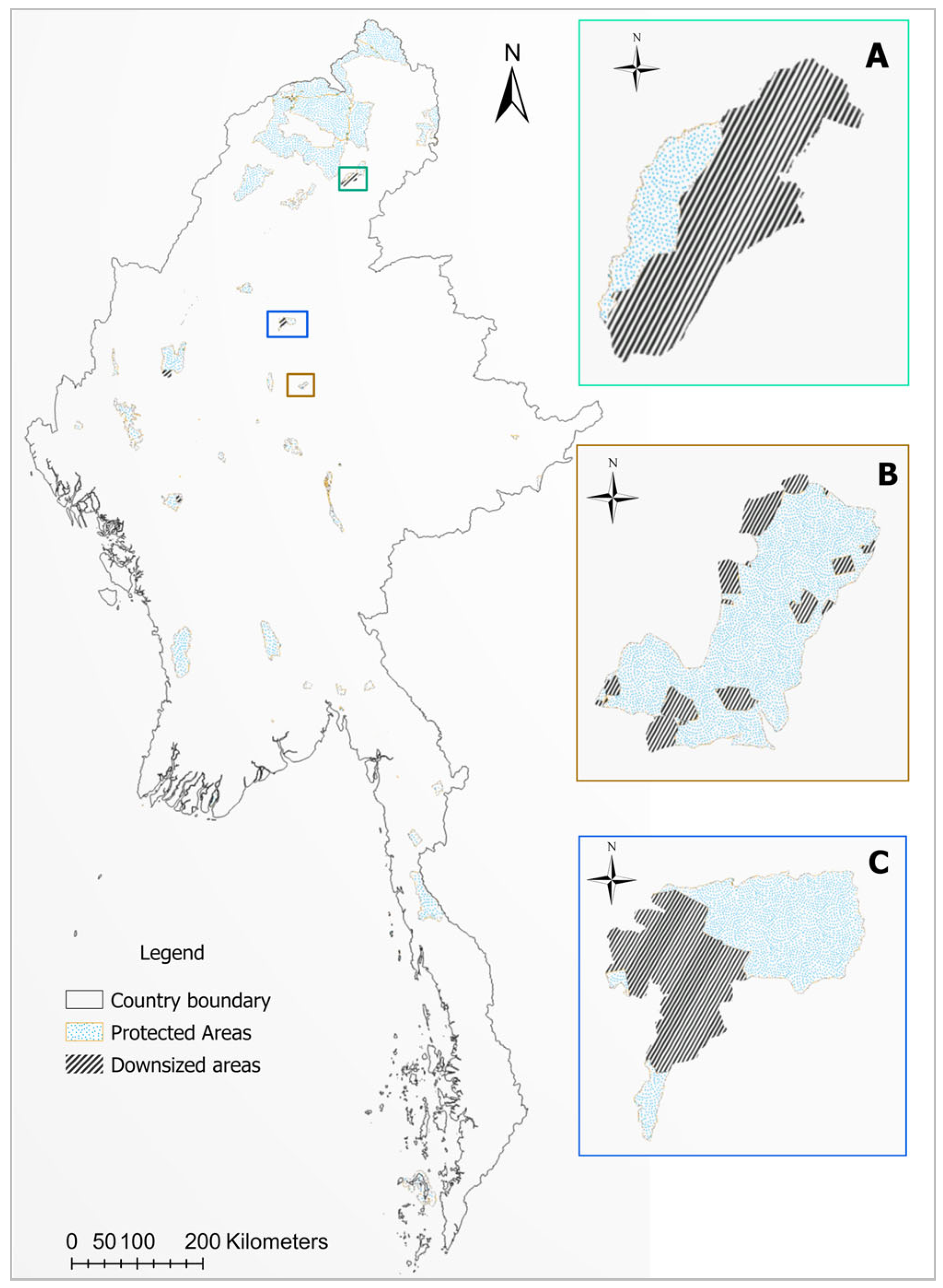

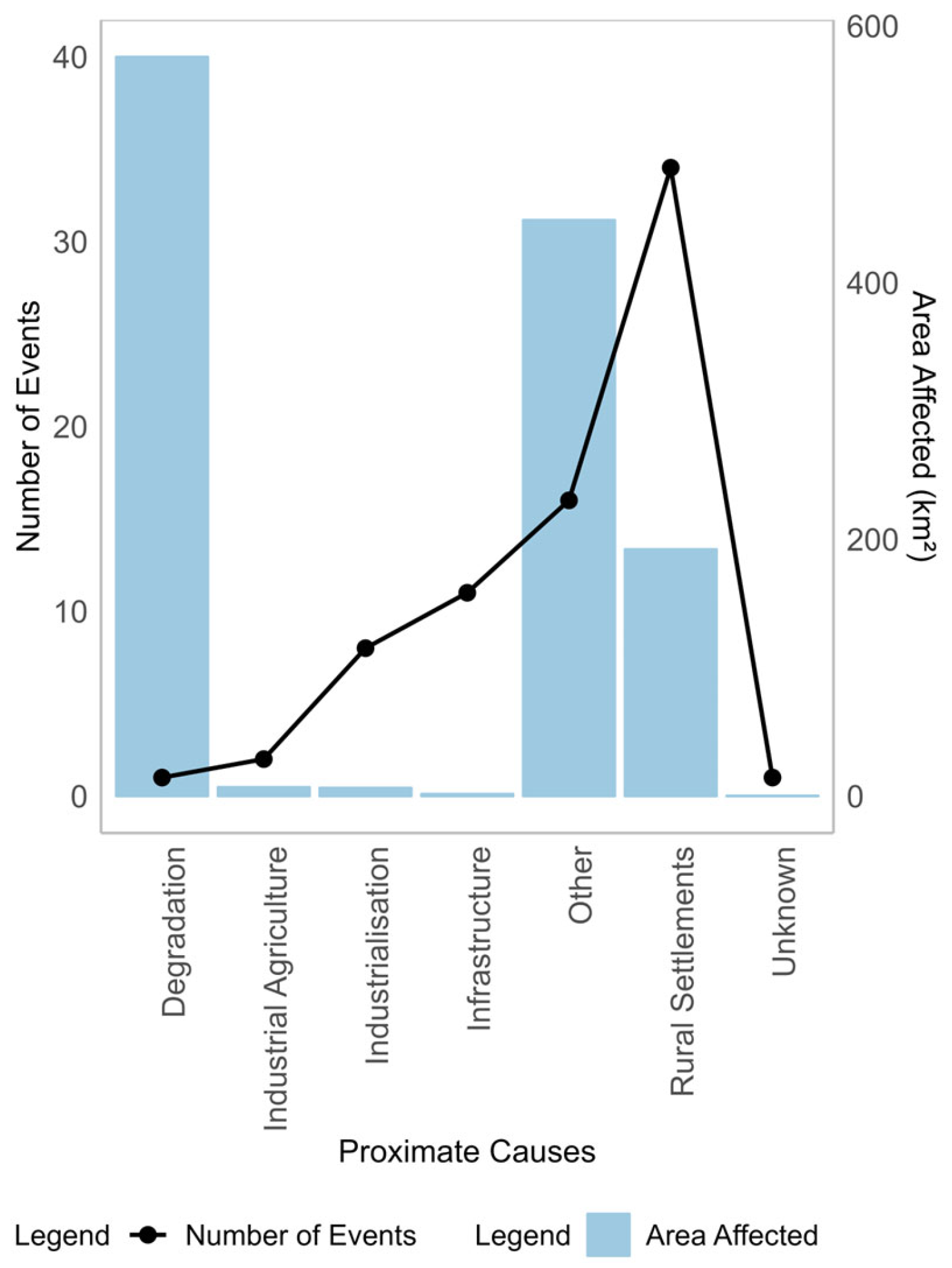
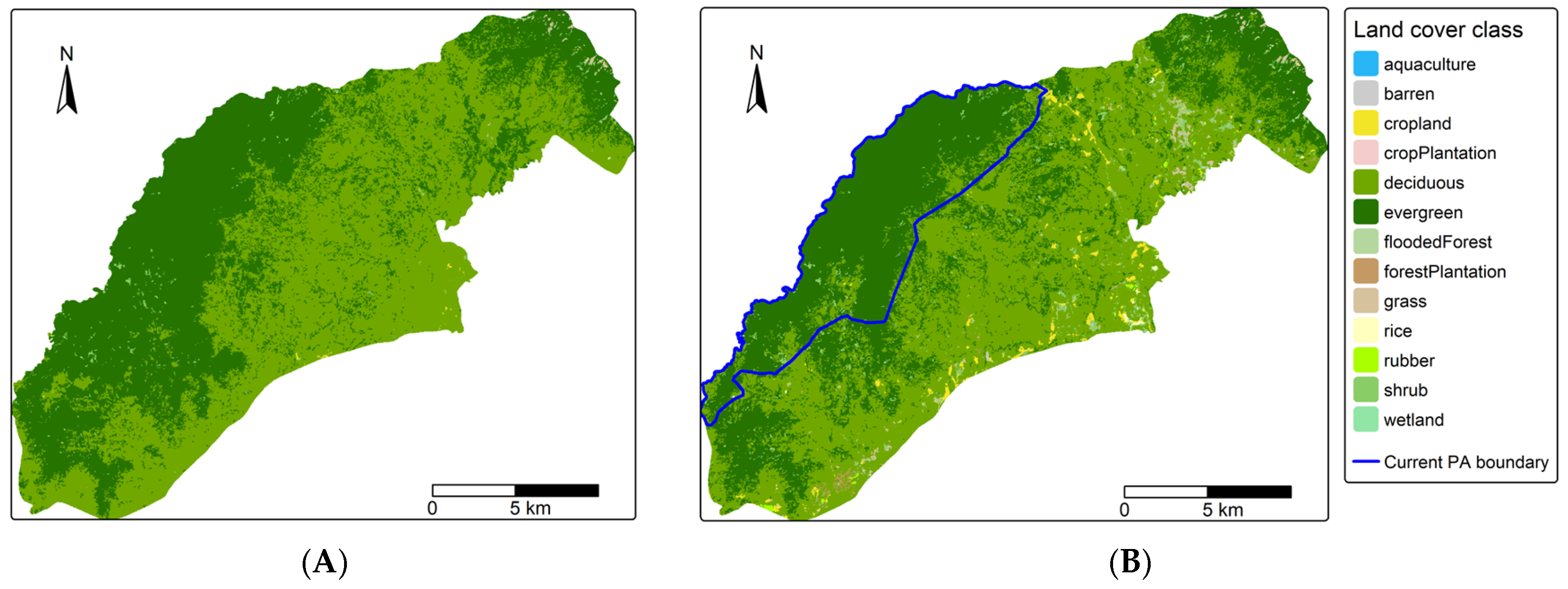
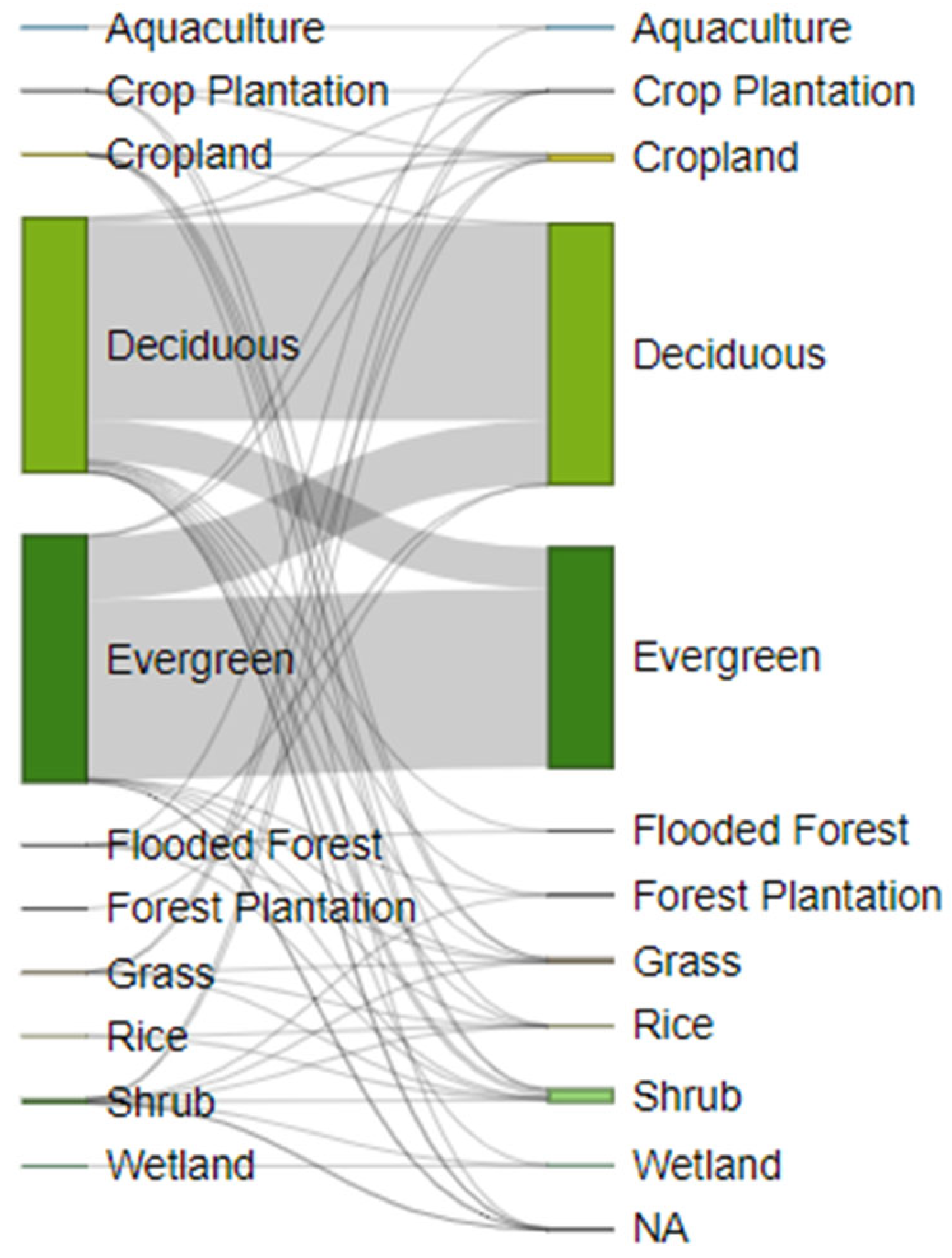

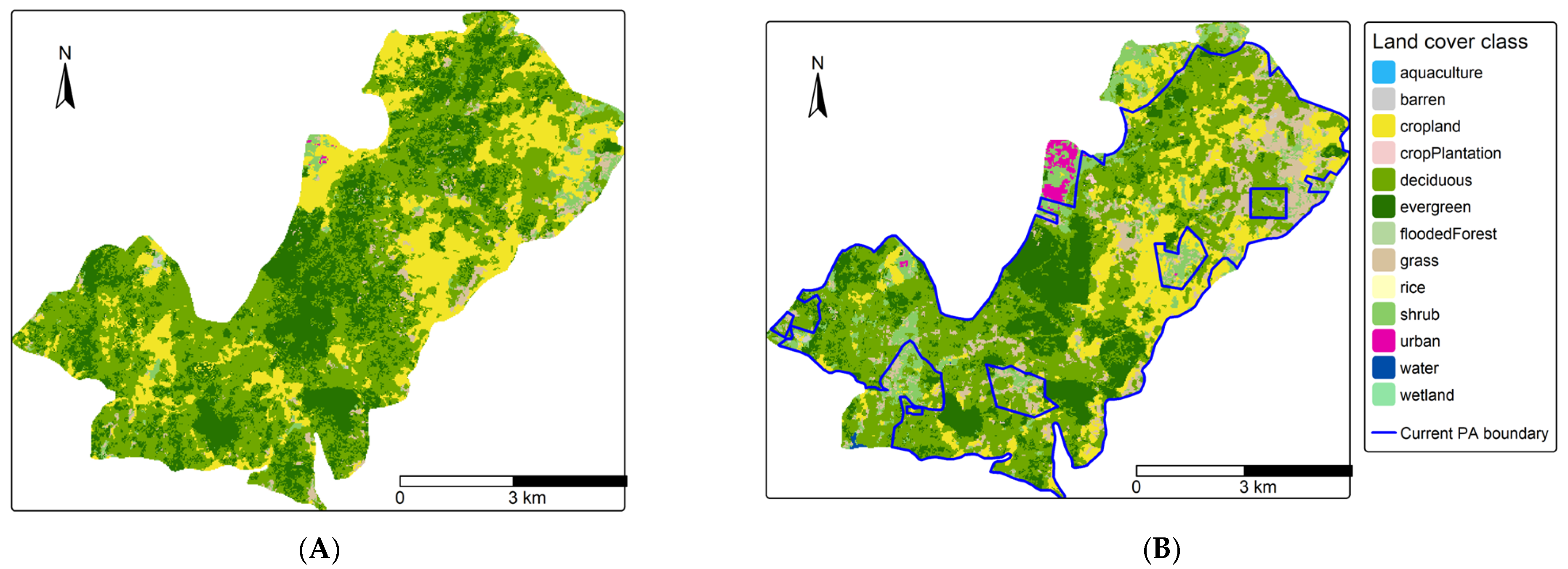
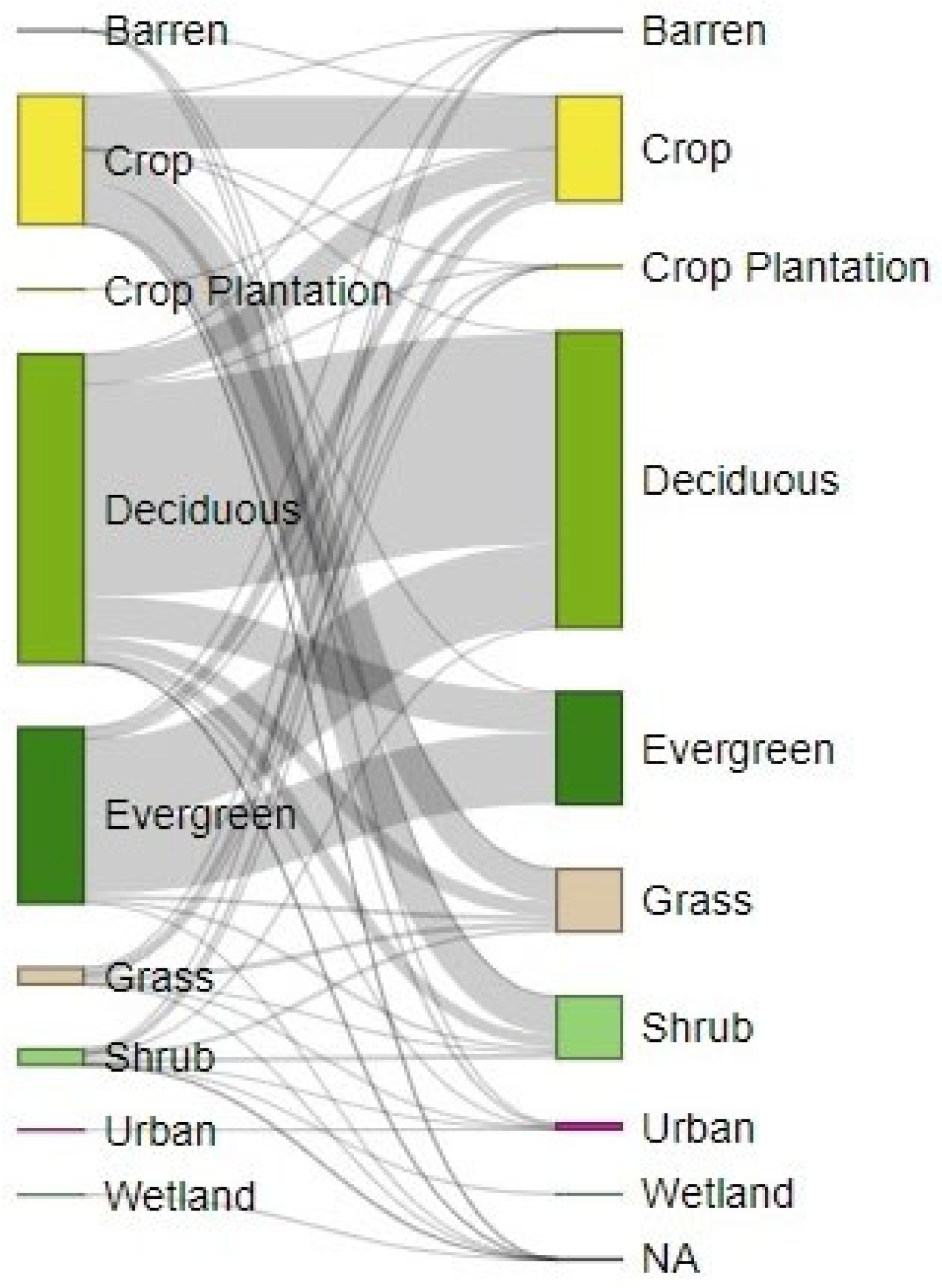
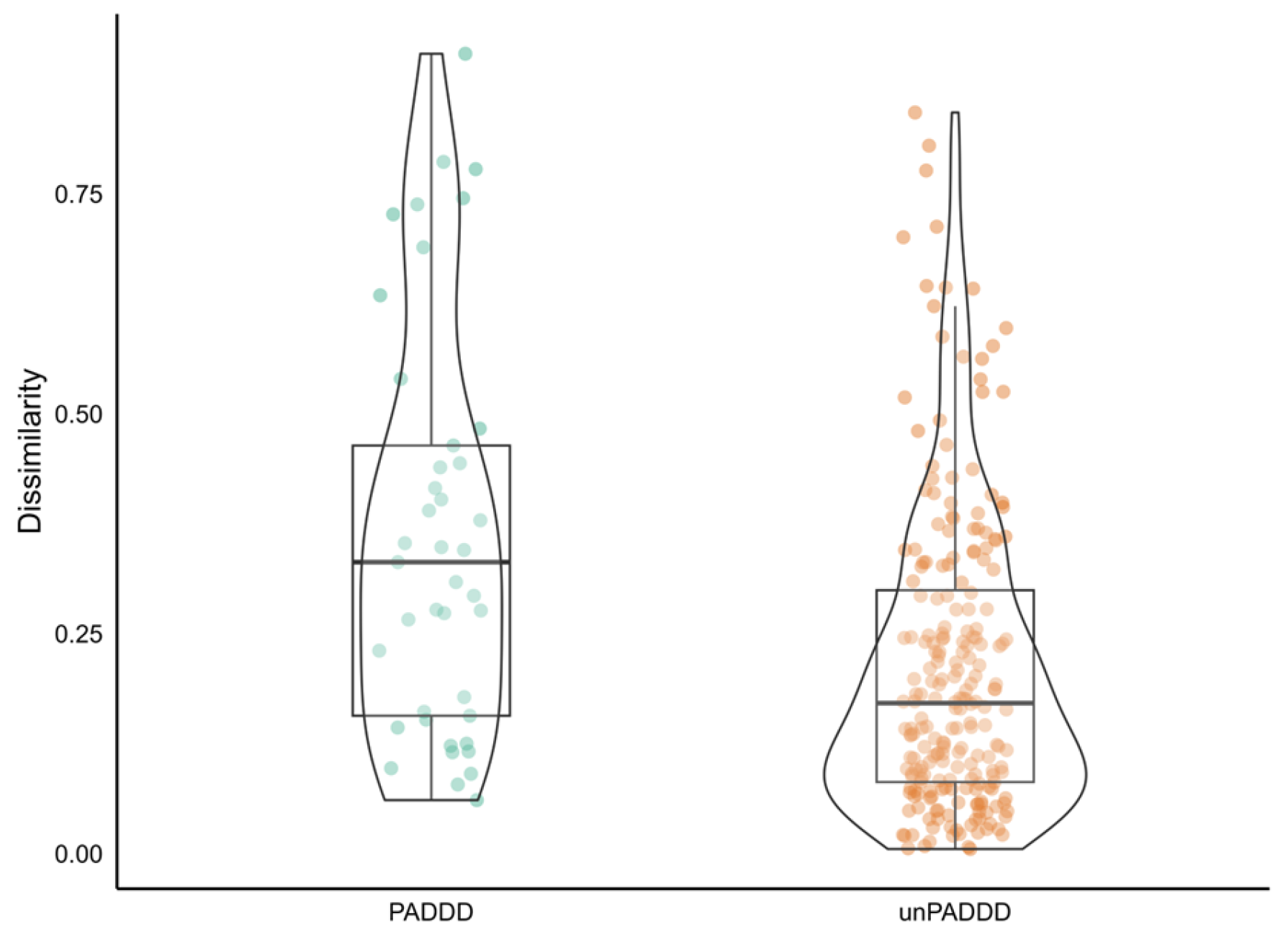
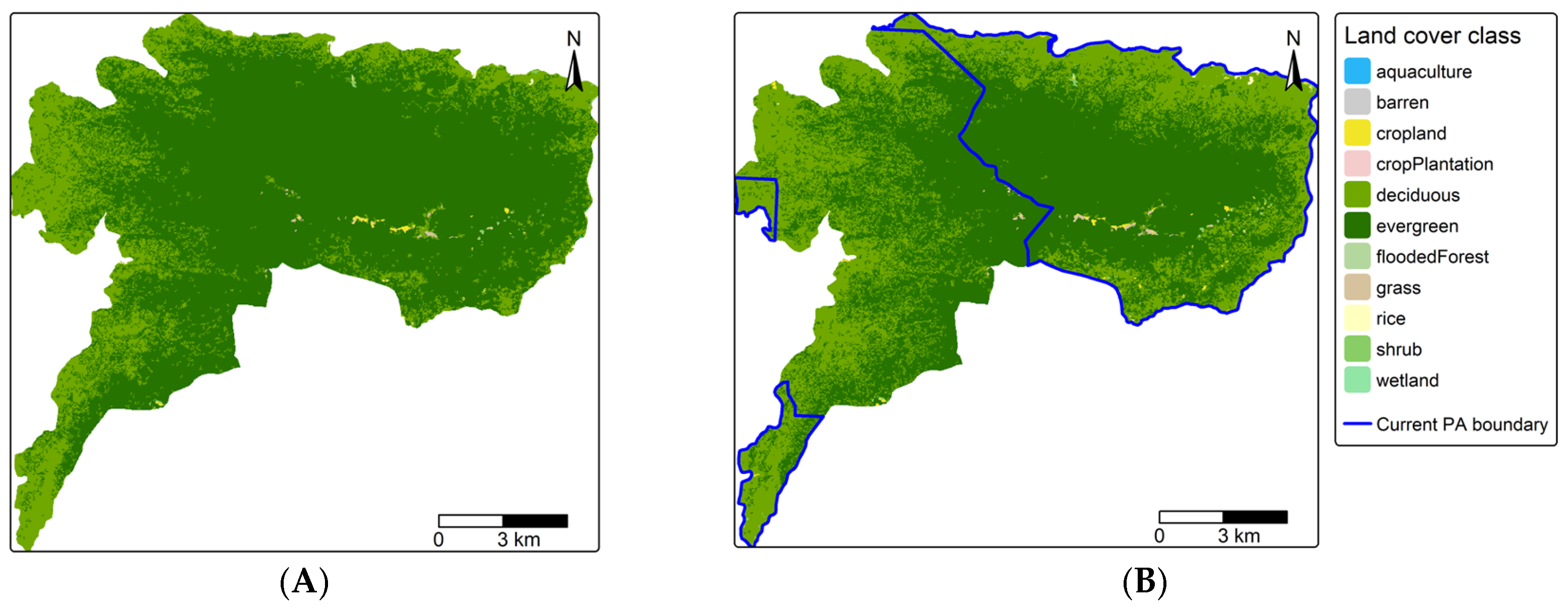
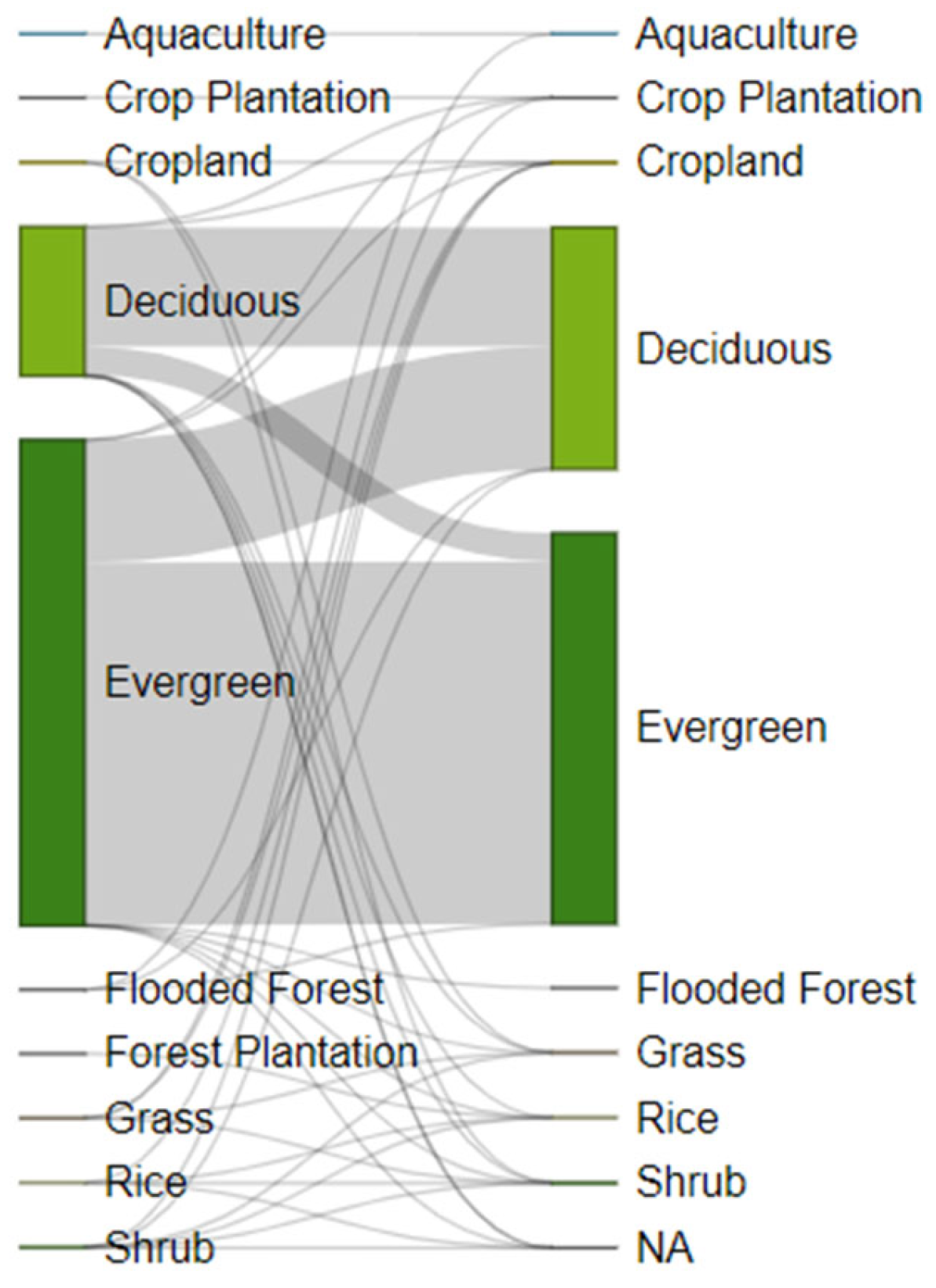
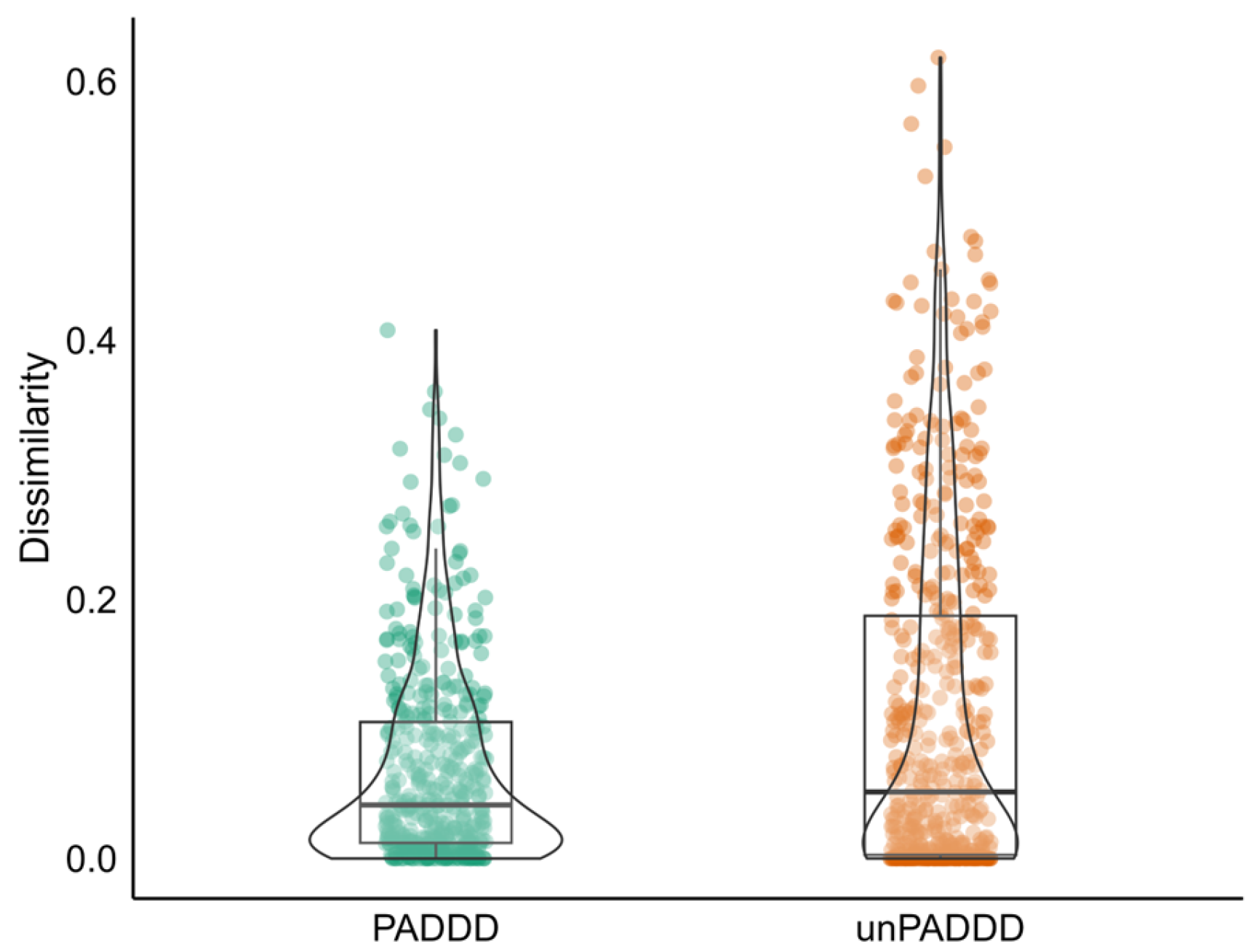
| Region | Number of Enacted PADDD Events | Area Affected (km2) | Average Area Affected per Event (km2) | ||||||
|---|---|---|---|---|---|---|---|---|---|
| Downgrade | Downsize | Degazette | Total | Downgrade | Downsize | Degazette | Total | ||
| Africa | 28 | 23 | 51 | 102 | 68,631.30 | 18,034.82 | 11,676.48 | 98,342.60 | 964.14 |
| Asia | 119 | 54 | 7 | 180 | 27,330.10 | 53,454.60 | 534.75 | 81,319.45 | 451.77 |
| Europe | 60 | - | - | 60 | 46,090.06 | - | - | 46,090.06 | 768.17 |
| Latin America | 47 | 76 | 14 | 137 | 73,758.05 | 60,558.47 | 19,158.93 | 153,475.45 | 1120.26 |
| North America | 240 | 13 | 1 | 254 | 526,198.76 | 8993.86 | 0.29 | 535,192.91 | 2107.06 |
| Oceania | 1150 | 122 | 108 | 1380 | 1,479,494.00 | 100,559.90 | 4097.40 | 1,584,151.30 | 1147.94 |
| Myanmar | - | 73 | - | 73 | - | 1231.40 | - | 1231.40 | 16.87 |
| Grand Total | 1644 | 361 | 181 | 2186 | 2,221,502.27 | 242,833.05 | 35,467.85 | 2,499,803.17 | 1143.55 |
| PA Name | Land Cover Class | Land Cover Area | Patch Area (Mean ± SD) | Core Area (Mean ± SD) | |||||||
|---|---|---|---|---|---|---|---|---|---|---|---|
| 2000 | 2020 | 2000 | 2020 | 2000 | 2020 | ||||||
| Patch Number | Area (ha) | Area (%) | Patch Number | Area (ha) | Area (%) | Area (ha) | Area (ha) | Area (ha) | Area (ha) | ||
| Pidaung | aquaculture | 3 | 1.19 | 0.002 | 3 | 1.43 | 0.003 | 0.40 ± 0.29 | 0.48 ± 0.21 | 0.05 ± 0.09 | 0.05 ± 0.09 |
| barren | - | - | - | 8 | 13.55 | 0.026 | - | 1.69 ± 2.20 | - | 0.58 ± 1.17 | |
| cropland | 64 | 31.55 | 0.060 | 383 | 611.67 | 1.166 | 0.49 ± 0.84 | 1.60 ± 3.88 | 0.06 ± 0.24 | 0.65 ± 2.29 | |
| crop plantation | 17 | 5.15 | 0.010 | 32 | 17.75 | 0.034 | 0.30 ± 0.38 | 0.55 ± 0.61 | 0.03 ± 0.08 | 0.08 ± 0.17 | |
| deciduous | 791 | 26,432.37 | 50.370 | 1542 | 27,093.34 | 51.630 | 33.42 ± 900.00 | 17.57 ± 641.00 | 25.16 ± 696.00 | 12.46 ± 477.00 | |
| evergreen | 2077 | 25,595.83 | 48.776 | 2431 | 22,851.66 | 43.547 | 12.32 ± 402.00 | 9.40 ± 332.00 | 9.34 ± 354.00 | 6.65 ± 263.00 | |
| flooded forest | 9 | 3.80 | 0.007 | 4 | 0.32 | 0.001 | 0.42 ± 0.38 | 0.08 | - | - | |
| forest plantation | 1 | 0.16 | - | 178 | 103.52 | 0.197 | 0.16 | 0.58 ± 1.29 | - | 0.05 ± 0.31 | |
| grass | 93 | 65.15 | 0.124 | 566 | 358.74 | 0.684 | 0.70 ± 1.32 | 0.63 ± 1.63 | 0.11 ± 0.39 | 0.10 ± 0.60 | |
| rice | 18 | 5.71 | 0.011 | 52 | 64.61 | 0.123 | 0.32 ± 0.32 | 1.24 ± 2.40 | 0.02 ± 0.08 | 0.43 ± 1.20 | |
| rubber | - | - | - | 46 | 75.14 | 0.143 | - | 1.63 ± 3.33 | - | 0.72 ± 2.05 | |
| shrub | 743 | 334.49 | 0.637 | 1907 | 1280.18 | 2.440 | 0.45 ± 0.77 | 0.67 ± 1.85 | 0.05 ± 0.24 | 0.11 ± 0.68 | |
| wetland | 5 | 0.79 | 0.002 | 6 | 4.28 | 0.008 | 0.16 ± 0.10 | 0.71 ± 1.29 | - | 0.11 ± 0.26 | |
| Pyin-Oo-Lwin | aquaculture | - | - | - | 1 | 0.08 | 0.001 | - | 0.08 | - | - |
| barren | 6 | 6.30 | 0.070 | 18 | 18.09 | 0.201 | 1.05 ± 2.25 | 1.01 ± 0.95 | 0.42 ± 1.04 | 0.19 ± 0.45 | |
| cropland | 494 | 1800.23 | 19.962 | 291 | 1463.50 | 16.228 | 3.64 ± 24.30 | 5.03 ± 25.10 | 2.16 ± 17.70 | 2.79 ± 17.30 | |
| crop plantation | 1 | 0.08 | 0.001 | 30 | 13.92 | 0.154 | 0.08 | 0.46 ± 0.76 | - | 0.07 ± 0.31 | |
| deciduous | 387 | 4316.07 | 47.859 | 306 | 4125.48 | 45.746 | 11.15 ± 132.00 | 13.48 ± 140.00 | 5.46 ± 69.60 | 8.00 ± 88.20 | |
| evergreen | 915 | 2442.82 | 27.088 | 656 | 1562.80 | 17.329 | 2.67 ± 28.00 | 2.38 ± 22.80 | 1.09 ± 15.30 | 1.32 ± 17.40 | |
| flooded forest | - | - | - | 1 | 0.33 | 0.004 | - | 0.33 | - | - | |
| grass | 333 | 228.74 | 2.536 | 610 | 873.30 | 9.684 | 0.69 ± 1.86 | 1.43 ± 10.10 | 0.13 ± 0.71 | 0.48 ± 5.21 | |
| rice | - | - | - | 2 | 1.72 | 0.019 | - | 0.86 ± 0.29 | - | - | |
| shrub | 289 | 220.23 | 2.442 | 477 | 868.96 | 9.636 | 0.76 ± 2.29 | 1.82 ± 8.80 | 0.18 ± 0.94 | 0.66 ± 4.58 | |
| urban | 9 | 3.68 | 0.041 | 15 | 81.62 | 0.905 | 0.41 ± 0.44 | 5.44 ± 13.10 | - | 2.81 ± 7.29 | |
| water | - | - | - | 4 | 8.27 | 0.092 | - | 2.07 ± 3.44 | - | 0.61 ± 1.23 | |
| wetland | 1 | 0.08 | 0.001 | 1 | 0.16 | 0.002 | 0.08 | 0.16 | - | - | |
| Shwe-U-Daung | aquaculture | 4 | 1.23 | 0.004 | 4 | 1.31 | 0.004 | 0.31 ± 0.26 | 0.33 ± 0.29 | 0.02 ± 0.04 | 0.02 ± 0.04 |
| barren | - | - | - | 4 | 1.80 | 0.006 | - | 0.45 ± 0.17 | - | - | |
| cropland | 42 | 45.56 | 0.139 | 89 | 77.46 | 0.237 | 1.08 ± 1.98 | 0.87 ± 1.11 | 0.32 ± 1.00 | 0.17 ± 0.46 | |
| crop plantation | 3 | 1.06 | 0.003 | 3 | 1.80 | 0.006 | 0.35 ± 0.29 | 0.60 ± 0.21 | - | 0.03 ± 0.05 | |
| deciduous | 1278 | 7640.36 | 23.362 | 1738 | 12,391.31 | 37.888 | 5.98 ± 79.90 | 7.13 ± 166.00 | 2.80 ± 46.80 | 3.72 ± 102.00 | |
| evergreen | 741 | 24,909.89 | 76.166 | 1558 | 20,037.31 | 61.267 | 33.62 ± 890.00 | 12.86 ± 475.00 | 27.79 ± 755.00 | 9.05 ± 354.00 | |
| flooded forest | 5 | 0.49 | 0.001 | 6 | 0.65 | 0.002 | 0.10 ± 0.04 | 0.11 ± 0.07 | - | - | |
| forest plantation | 1 | 0.08 | - | - | - | - | 0.08 | - | - | - | |
| grass | 56 | 39.10 | 0.120 | 50 | 59.14 | 0.181 | 0.70 ± 1.47 | 1.18 ± 2.26 | 0.16 ± 0.76 | 0.31 ± 0.95 | |
| rice | 19 | 18.32 | 0.056 | 24 | 45.89 | 0.140 | 0.96 ± 0.98 | 1.91 ± 2.41 | 0.18 ± 0.33 | 0.64 ± 1.18 | |
| shrub | 123 | 48.67 | 0.149 | 195 | 84.58 | 0.259 | 0.40 ± 0.90 | 0.43 ± 0.86 | 0.06 ± 0.32 | 0.05 ± 0.30 | |
| wetland | - | - | - | 2 | 3.52 | 0.011 | - | 1.76 ± 1.45 | - | - | |
| Scientific Name | IUCN Red List Status | Percent of Range in Pidaung (%) | Percent of Range in Pyin-Oo-Lwin (%) | Percent of Range in Shwe-U-Daung (%) | ||||
|---|---|---|---|---|---|---|---|---|
| Myanmar | Global | UnPADDD | PADDD | UnPADDD | PADDD | UnPADDD | PADDD | |
| Hoolock leuconedys | VU | VU | 3.76 | 71.27 | - | - | 95.77 | 82.97 |
| Trachypithecus shortridgei | EN | EN | 100.00 | 100.00 | - | - | - | - |
| Coelops frithii | EN | NT | 100.00 | 100.00 | - | - | 66.90 | - |
| Cynopterus brachyotis | VU | LC | 100.00 | 100.00 | 100.00 | 100.00 | 33.10 | 100.00 |
| Hipposideros lylei | EN | LC | 100.00 | 100.00 | 100.00 | 100.00 | 100.00 | 100.00 |
| Panthera pardus | EN | VU | - | - | - | - | 87.24 | 0.42 |
| Ursus thibetanus | VU | VU | 100.00 | 100.00 | - | - | 100.00 | 100.00 |
| Elephas maximus | EN | EN | - | 0.84 | 14.40 | 9.78 | 27.18 | 100.00 |
| Helarctos malayanus | VU | VU | 100.00 | 100.00 | - | - | 97.44 | 100.00 |
| Amyda ornate phayrei | CR | NA | 100.00 | 100.00 | 100.00 | 100.00 | 100.00 | 100.00 |
| Cuora mouhotii | CR | EN | 100.00 | 100.00 | - | - | 66.90 | - |
| Heosemys grandis | CR | VU | 100.00 | 100.00 | - | - | - | - |
| Manouria impressa | CR | VU | 100.00 | 100.00 | - | - | 66.90 | - |
| Platystenon megacephalum | CR | EN | - | - | - | - | 66.89 | - |
Disclaimer/Publisher’s Note: The statements, opinions and data contained in all publications are solely those of the individual author(s) and contributor(s) and not of MDPI and/or the editor(s). MDPI and/or the editor(s) disclaim responsibility for any injury to people or property resulting from any ideas, methods, instructions or products referred to in the content. |
© 2025 by the authors. Licensee MDPI, Basel, Switzerland. This article is an open access article distributed under the terms and conditions of the Creative Commons Attribution (CC BY) license (https://creativecommons.org/licenses/by/4.0/).
Share and Cite
Thant, Z.M.; Røskaft, E.; Hunt, G.; Mon, M.S.; Tun, T.Z.; Oswald, P.; Rueff, H. Protected Areas Under Threat: Unravelling the Protected Areas Downgrading, Downsizing, and Degazettement (PADDD) Events in Myanmar in a Global Context: 1989–2020. Land 2025, 14, 1800. https://doi.org/10.3390/land14091800
Thant ZM, Røskaft E, Hunt G, Mon MS, Tun TZ, Oswald P, Rueff H. Protected Areas Under Threat: Unravelling the Protected Areas Downgrading, Downsizing, and Degazettement (PADDD) Events in Myanmar in a Global Context: 1989–2020. Land. 2025; 14(9):1800. https://doi.org/10.3390/land14091800
Chicago/Turabian StyleThant, Zaw Min, Eivin Røskaft, Glenn Hunt, Myat Su Mon, Thaw Zin Tun, Patrick Oswald, and Henri Rueff. 2025. "Protected Areas Under Threat: Unravelling the Protected Areas Downgrading, Downsizing, and Degazettement (PADDD) Events in Myanmar in a Global Context: 1989–2020" Land 14, no. 9: 1800. https://doi.org/10.3390/land14091800
APA StyleThant, Z. M., Røskaft, E., Hunt, G., Mon, M. S., Tun, T. Z., Oswald, P., & Rueff, H. (2025). Protected Areas Under Threat: Unravelling the Protected Areas Downgrading, Downsizing, and Degazettement (PADDD) Events in Myanmar in a Global Context: 1989–2020. Land, 14(9), 1800. https://doi.org/10.3390/land14091800




